Analysis of Leadership and Management in Tesco's Operations
VerifiedAdded on 2021/02/21
|16
|5652
|443
Report
AI Summary
This report provides a comprehensive analysis of leadership and management within Tesco, a major international retail company. It begins by comparing the roles and characteristics of leaders and managers, highlighting their distinct responsibilities and approaches. The report then examines the application of these roles in various situations, particularly addressing Tesco's current challenges, such as declining sales and consolidation strategies. Different leadership theories, including situational leadership, are applied to analyze their impact on Tesco's practices. The report further explores key approaches to operations management, emphasizing the importance of effective leadership and management in this area, and identifies factors affecting the business environment. Overall, the report provides a detailed overview of leadership and management principles and their practical application within a real-world business context.
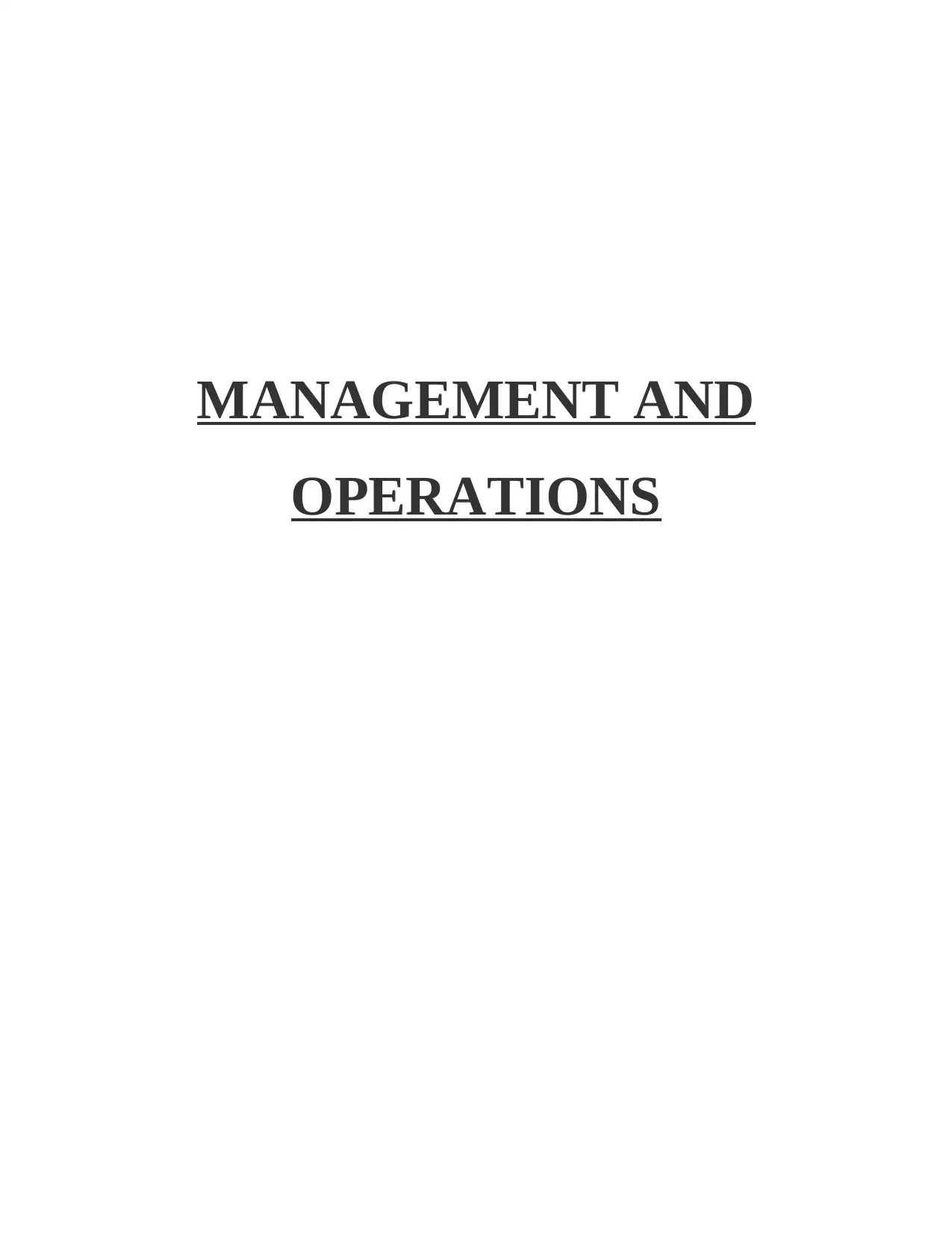
MANAGEMENT AND
OPERATIONS
OPERATIONS
Paraphrase This Document
Need a fresh take? Get an instant paraphrase of this document with our AI Paraphraser
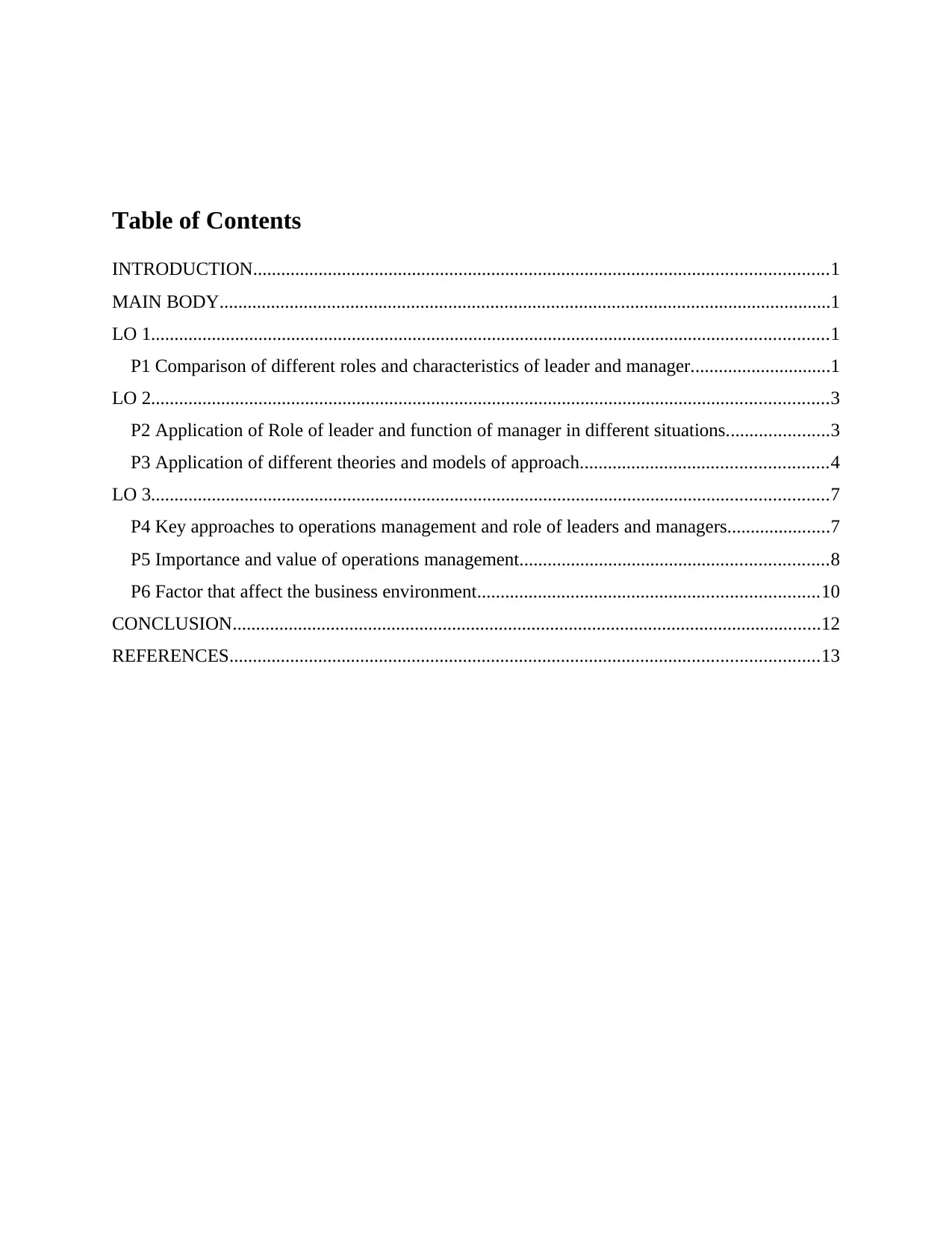
Table of Contents
INTRODUCTION...........................................................................................................................1
MAIN BODY...................................................................................................................................1
LO 1.................................................................................................................................................1
P1 Comparison of different roles and characteristics of leader and manager..............................1
LO 2.................................................................................................................................................3
P2 Application of Role of leader and function of manager in different situations......................3
P3 Application of different theories and models of approach.....................................................4
LO 3.................................................................................................................................................7
P4 Key approaches to operations management and role of leaders and managers......................7
P5 Importance and value of operations management..................................................................8
P6 Factor that affect the business environment.........................................................................10
CONCLUSION..............................................................................................................................12
REFERENCES..............................................................................................................................13
INTRODUCTION...........................................................................................................................1
MAIN BODY...................................................................................................................................1
LO 1.................................................................................................................................................1
P1 Comparison of different roles and characteristics of leader and manager..............................1
LO 2.................................................................................................................................................3
P2 Application of Role of leader and function of manager in different situations......................3
P3 Application of different theories and models of approach.....................................................4
LO 3.................................................................................................................................................7
P4 Key approaches to operations management and role of leaders and managers......................7
P5 Importance and value of operations management..................................................................8
P6 Factor that affect the business environment.........................................................................10
CONCLUSION..............................................................................................................................12
REFERENCES..............................................................................................................................13
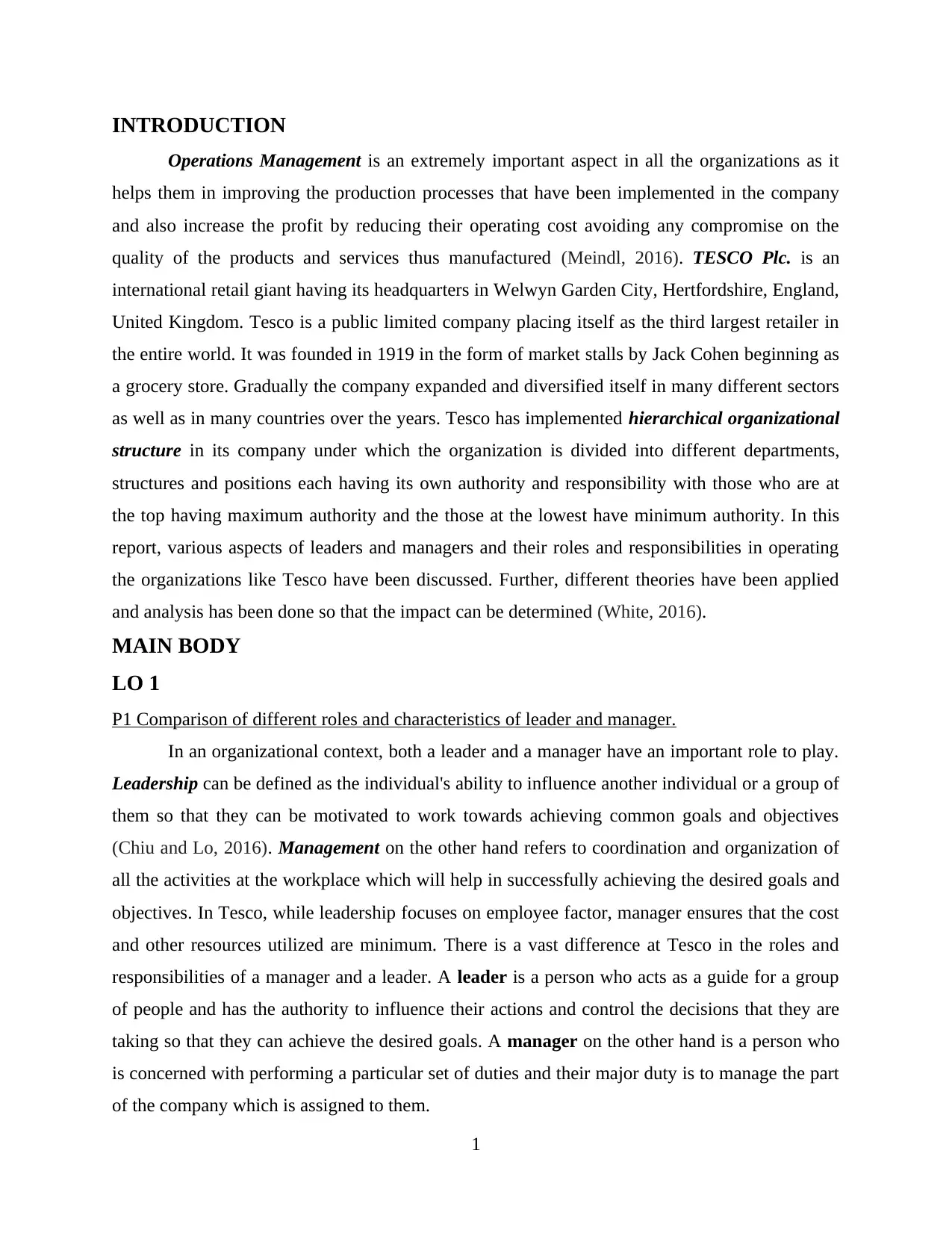
INTRODUCTION
Operations Management is an extremely important aspect in all the organizations as it
helps them in improving the production processes that have been implemented in the company
and also increase the profit by reducing their operating cost avoiding any compromise on the
quality of the products and services thus manufactured (Meindl, 2016). TESCO Plc. is an
international retail giant having its headquarters in Welwyn Garden City, Hertfordshire, England,
United Kingdom. Tesco is a public limited company placing itself as the third largest retailer in
the entire world. It was founded in 1919 in the form of market stalls by Jack Cohen beginning as
a grocery store. Gradually the company expanded and diversified itself in many different sectors
as well as in many countries over the years. Tesco has implemented hierarchical organizational
structure in its company under which the organization is divided into different departments,
structures and positions each having its own authority and responsibility with those who are at
the top having maximum authority and the those at the lowest have minimum authority. In this
report, various aspects of leaders and managers and their roles and responsibilities in operating
the organizations like Tesco have been discussed. Further, different theories have been applied
and analysis has been done so that the impact can be determined (White, 2016).
MAIN BODY
LO 1
P1 Comparison of different roles and characteristics of leader and manager.
In an organizational context, both a leader and a manager have an important role to play.
Leadership can be defined as the individual's ability to influence another individual or a group of
them so that they can be motivated to work towards achieving common goals and objectives
(Chiu and Lo, 2016). Management on the other hand refers to coordination and organization of
all the activities at the workplace which will help in successfully achieving the desired goals and
objectives. In Tesco, while leadership focuses on employee factor, manager ensures that the cost
and other resources utilized are minimum. There is a vast difference at Tesco in the roles and
responsibilities of a manager and a leader. A leader is a person who acts as a guide for a group
of people and has the authority to influence their actions and control the decisions that they are
taking so that they can achieve the desired goals. A manager on the other hand is a person who
is concerned with performing a particular set of duties and their major duty is to manage the part
of the company which is assigned to them.
1
Operations Management is an extremely important aspect in all the organizations as it
helps them in improving the production processes that have been implemented in the company
and also increase the profit by reducing their operating cost avoiding any compromise on the
quality of the products and services thus manufactured (Meindl, 2016). TESCO Plc. is an
international retail giant having its headquarters in Welwyn Garden City, Hertfordshire, England,
United Kingdom. Tesco is a public limited company placing itself as the third largest retailer in
the entire world. It was founded in 1919 in the form of market stalls by Jack Cohen beginning as
a grocery store. Gradually the company expanded and diversified itself in many different sectors
as well as in many countries over the years. Tesco has implemented hierarchical organizational
structure in its company under which the organization is divided into different departments,
structures and positions each having its own authority and responsibility with those who are at
the top having maximum authority and the those at the lowest have minimum authority. In this
report, various aspects of leaders and managers and their roles and responsibilities in operating
the organizations like Tesco have been discussed. Further, different theories have been applied
and analysis has been done so that the impact can be determined (White, 2016).
MAIN BODY
LO 1
P1 Comparison of different roles and characteristics of leader and manager.
In an organizational context, both a leader and a manager have an important role to play.
Leadership can be defined as the individual's ability to influence another individual or a group of
them so that they can be motivated to work towards achieving common goals and objectives
(Chiu and Lo, 2016). Management on the other hand refers to coordination and organization of
all the activities at the workplace which will help in successfully achieving the desired goals and
objectives. In Tesco, while leadership focuses on employee factor, manager ensures that the cost
and other resources utilized are minimum. There is a vast difference at Tesco in the roles and
responsibilities of a manager and a leader. A leader is a person who acts as a guide for a group
of people and has the authority to influence their actions and control the decisions that they are
taking so that they can achieve the desired goals. A manager on the other hand is a person who
is concerned with performing a particular set of duties and their major duty is to manage the part
of the company which is assigned to them.
1
⊘ This is a preview!⊘
Do you want full access?
Subscribe today to unlock all pages.

Trusted by 1+ million students worldwide
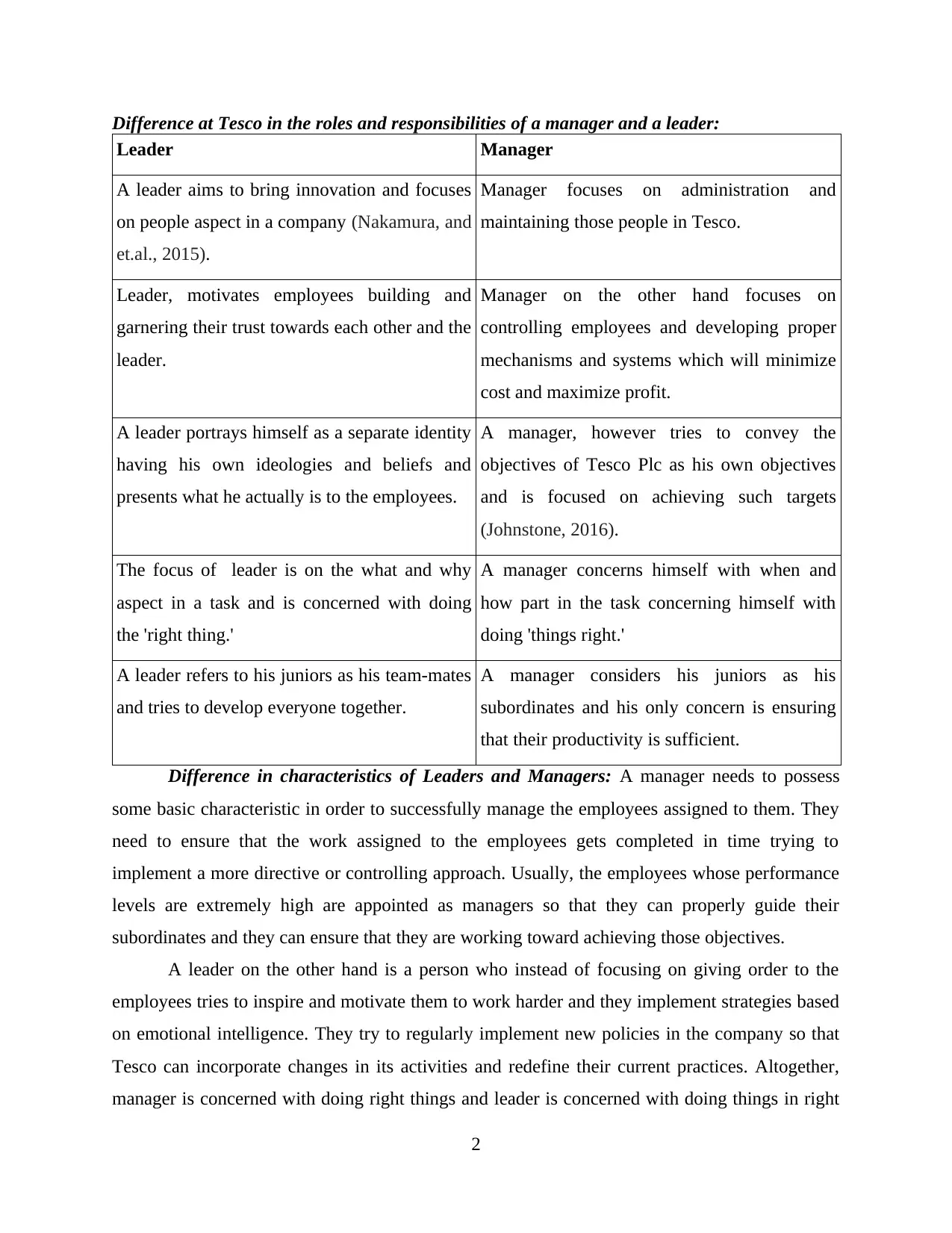
Difference at Tesco in the roles and responsibilities of a manager and a leader:
Leader Manager
A leader aims to bring innovation and focuses
on people aspect in a company (Nakamura, and
et.al., 2015).
Manager focuses on administration and
maintaining those people in Tesco.
Leader, motivates employees building and
garnering their trust towards each other and the
leader.
Manager on the other hand focuses on
controlling employees and developing proper
mechanisms and systems which will minimize
cost and maximize profit.
A leader portrays himself as a separate identity
having his own ideologies and beliefs and
presents what he actually is to the employees.
A manager, however tries to convey the
objectives of Tesco Plc as his own objectives
and is focused on achieving such targets
(Johnstone, 2016).
The focus of leader is on the what and why
aspect in a task and is concerned with doing
the 'right thing.'
A manager concerns himself with when and
how part in the task concerning himself with
doing 'things right.'
A leader refers to his juniors as his team-mates
and tries to develop everyone together.
A manager considers his juniors as his
subordinates and his only concern is ensuring
that their productivity is sufficient.
Difference in characteristics of Leaders and Managers: A manager needs to possess
some basic characteristic in order to successfully manage the employees assigned to them. They
need to ensure that the work assigned to the employees gets completed in time trying to
implement a more directive or controlling approach. Usually, the employees whose performance
levels are extremely high are appointed as managers so that they can properly guide their
subordinates and they can ensure that they are working toward achieving those objectives.
A leader on the other hand is a person who instead of focusing on giving order to the
employees tries to inspire and motivate them to work harder and they implement strategies based
on emotional intelligence. They try to regularly implement new policies in the company so that
Tesco can incorporate changes in its activities and redefine their current practices. Altogether,
manager is concerned with doing right things and leader is concerned with doing things in right
2
Leader Manager
A leader aims to bring innovation and focuses
on people aspect in a company (Nakamura, and
et.al., 2015).
Manager focuses on administration and
maintaining those people in Tesco.
Leader, motivates employees building and
garnering their trust towards each other and the
leader.
Manager on the other hand focuses on
controlling employees and developing proper
mechanisms and systems which will minimize
cost and maximize profit.
A leader portrays himself as a separate identity
having his own ideologies and beliefs and
presents what he actually is to the employees.
A manager, however tries to convey the
objectives of Tesco Plc as his own objectives
and is focused on achieving such targets
(Johnstone, 2016).
The focus of leader is on the what and why
aspect in a task and is concerned with doing
the 'right thing.'
A manager concerns himself with when and
how part in the task concerning himself with
doing 'things right.'
A leader refers to his juniors as his team-mates
and tries to develop everyone together.
A manager considers his juniors as his
subordinates and his only concern is ensuring
that their productivity is sufficient.
Difference in characteristics of Leaders and Managers: A manager needs to possess
some basic characteristic in order to successfully manage the employees assigned to them. They
need to ensure that the work assigned to the employees gets completed in time trying to
implement a more directive or controlling approach. Usually, the employees whose performance
levels are extremely high are appointed as managers so that they can properly guide their
subordinates and they can ensure that they are working toward achieving those objectives.
A leader on the other hand is a person who instead of focusing on giving order to the
employees tries to inspire and motivate them to work harder and they implement strategies based
on emotional intelligence. They try to regularly implement new policies in the company so that
Tesco can incorporate changes in its activities and redefine their current practices. Altogether,
manager is concerned with doing right things and leader is concerned with doing things in right
2
Paraphrase This Document
Need a fresh take? Get an instant paraphrase of this document with our AI Paraphraser
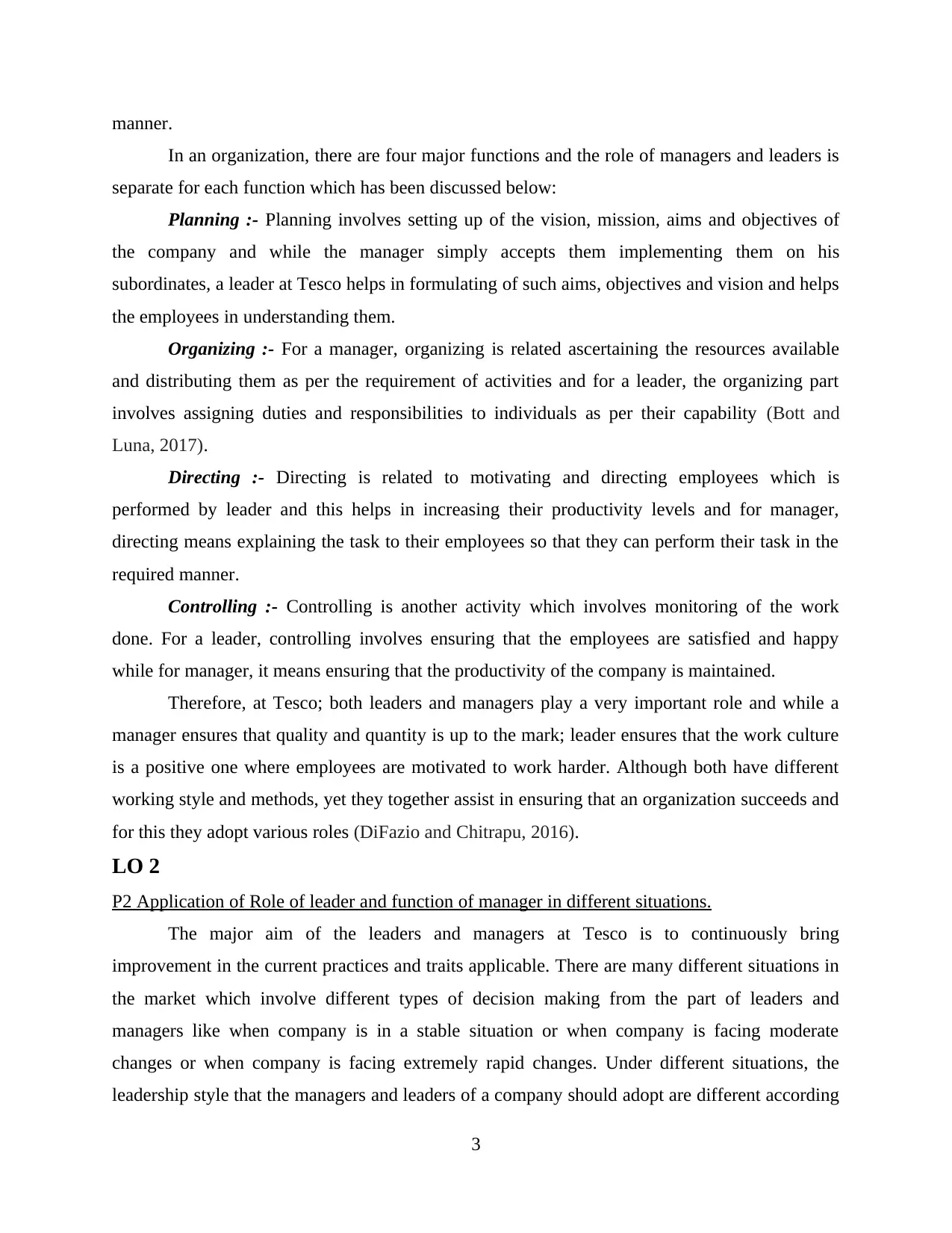
manner.
In an organization, there are four major functions and the role of managers and leaders is
separate for each function which has been discussed below:
Planning :- Planning involves setting up of the vision, mission, aims and objectives of
the company and while the manager simply accepts them implementing them on his
subordinates, a leader at Tesco helps in formulating of such aims, objectives and vision and helps
the employees in understanding them.
Organizing :- For a manager, organizing is related ascertaining the resources available
and distributing them as per the requirement of activities and for a leader, the organizing part
involves assigning duties and responsibilities to individuals as per their capability (Bott and
Luna, 2017).
Directing :- Directing is related to motivating and directing employees which is
performed by leader and this helps in increasing their productivity levels and for manager,
directing means explaining the task to their employees so that they can perform their task in the
required manner.
Controlling :- Controlling is another activity which involves monitoring of the work
done. For a leader, controlling involves ensuring that the employees are satisfied and happy
while for manager, it means ensuring that the productivity of the company is maintained.
Therefore, at Tesco; both leaders and managers play a very important role and while a
manager ensures that quality and quantity is up to the mark; leader ensures that the work culture
is a positive one where employees are motivated to work harder. Although both have different
working style and methods, yet they together assist in ensuring that an organization succeeds and
for this they adopt various roles (DiFazio and Chitrapu, 2016).
LO 2
P2 Application of Role of leader and function of manager in different situations.
The major aim of the leaders and managers at Tesco is to continuously bring
improvement in the current practices and traits applicable. There are many different situations in
the market which involve different types of decision making from the part of leaders and
managers like when company is in a stable situation or when company is facing moderate
changes or when company is facing extremely rapid changes. Under different situations, the
leadership style that the managers and leaders of a company should adopt are different according
3
In an organization, there are four major functions and the role of managers and leaders is
separate for each function which has been discussed below:
Planning :- Planning involves setting up of the vision, mission, aims and objectives of
the company and while the manager simply accepts them implementing them on his
subordinates, a leader at Tesco helps in formulating of such aims, objectives and vision and helps
the employees in understanding them.
Organizing :- For a manager, organizing is related ascertaining the resources available
and distributing them as per the requirement of activities and for a leader, the organizing part
involves assigning duties and responsibilities to individuals as per their capability (Bott and
Luna, 2017).
Directing :- Directing is related to motivating and directing employees which is
performed by leader and this helps in increasing their productivity levels and for manager,
directing means explaining the task to their employees so that they can perform their task in the
required manner.
Controlling :- Controlling is another activity which involves monitoring of the work
done. For a leader, controlling involves ensuring that the employees are satisfied and happy
while for manager, it means ensuring that the productivity of the company is maintained.
Therefore, at Tesco; both leaders and managers play a very important role and while a
manager ensures that quality and quantity is up to the mark; leader ensures that the work culture
is a positive one where employees are motivated to work harder. Although both have different
working style and methods, yet they together assist in ensuring that an organization succeeds and
for this they adopt various roles (DiFazio and Chitrapu, 2016).
LO 2
P2 Application of Role of leader and function of manager in different situations.
The major aim of the leaders and managers at Tesco is to continuously bring
improvement in the current practices and traits applicable. There are many different situations in
the market which involve different types of decision making from the part of leaders and
managers like when company is in a stable situation or when company is facing moderate
changes or when company is facing extremely rapid changes. Under different situations, the
leadership style that the managers and leaders of a company should adopt are different according
3
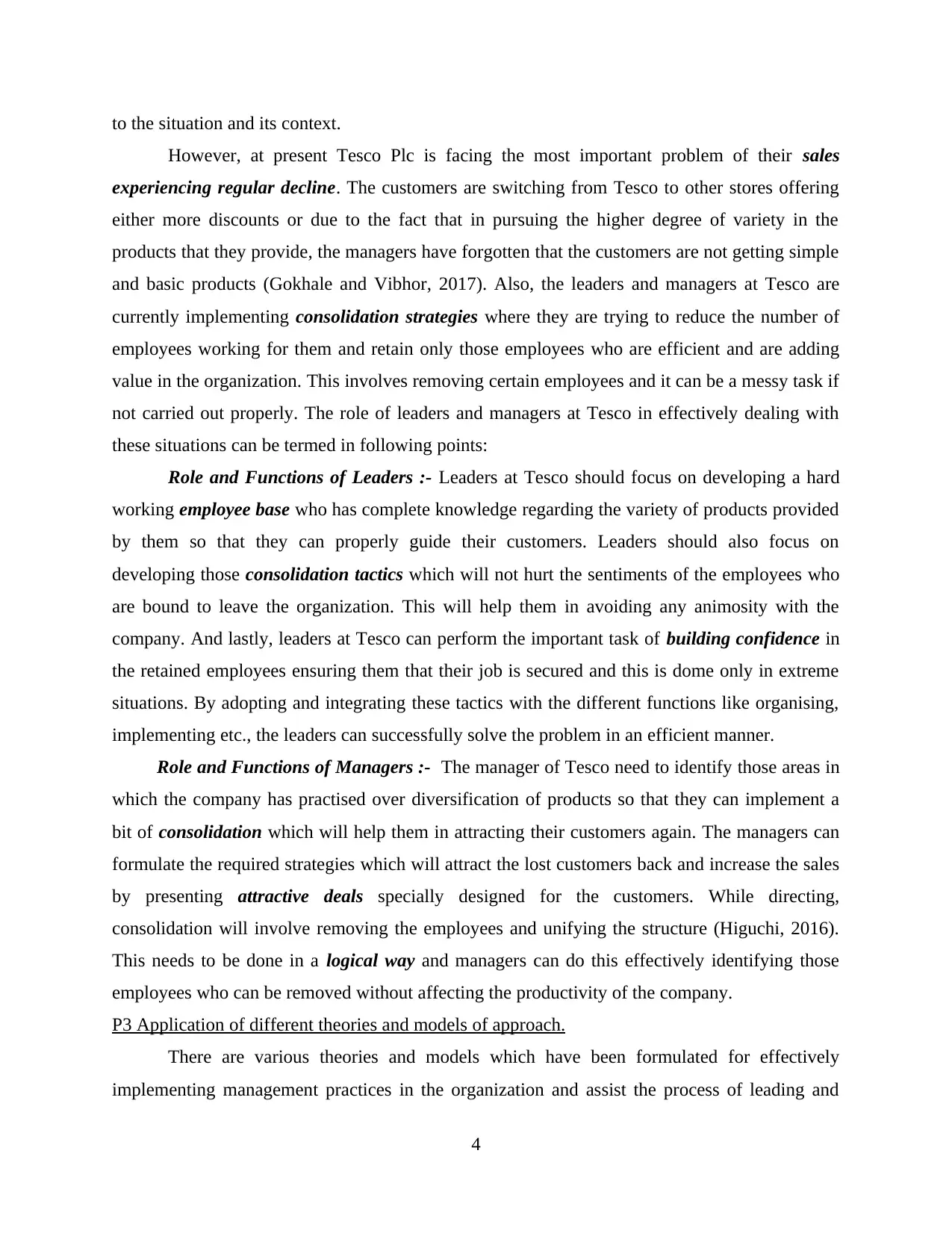
to the situation and its context.
However, at present Tesco Plc is facing the most important problem of their sales
experiencing regular decline. The customers are switching from Tesco to other stores offering
either more discounts or due to the fact that in pursuing the higher degree of variety in the
products that they provide, the managers have forgotten that the customers are not getting simple
and basic products (Gokhale and Vibhor, 2017). Also, the leaders and managers at Tesco are
currently implementing consolidation strategies where they are trying to reduce the number of
employees working for them and retain only those employees who are efficient and are adding
value in the organization. This involves removing certain employees and it can be a messy task if
not carried out properly. The role of leaders and managers at Tesco in effectively dealing with
these situations can be termed in following points:
Role and Functions of Leaders :- Leaders at Tesco should focus on developing a hard
working employee base who has complete knowledge regarding the variety of products provided
by them so that they can properly guide their customers. Leaders should also focus on
developing those consolidation tactics which will not hurt the sentiments of the employees who
are bound to leave the organization. This will help them in avoiding any animosity with the
company. And lastly, leaders at Tesco can perform the important task of building confidence in
the retained employees ensuring them that their job is secured and this is dome only in extreme
situations. By adopting and integrating these tactics with the different functions like organising,
implementing etc., the leaders can successfully solve the problem in an efficient manner.
Role and Functions of Managers :- The manager of Tesco need to identify those areas in
which the company has practised over diversification of products so that they can implement a
bit of consolidation which will help them in attracting their customers again. The managers can
formulate the required strategies which will attract the lost customers back and increase the sales
by presenting attractive deals specially designed for the customers. While directing,
consolidation will involve removing the employees and unifying the structure (Higuchi, 2016).
This needs to be done in a logical way and managers can do this effectively identifying those
employees who can be removed without affecting the productivity of the company.
P3 Application of different theories and models of approach.
There are various theories and models which have been formulated for effectively
implementing management practices in the organization and assist the process of leading and
4
However, at present Tesco Plc is facing the most important problem of their sales
experiencing regular decline. The customers are switching from Tesco to other stores offering
either more discounts or due to the fact that in pursuing the higher degree of variety in the
products that they provide, the managers have forgotten that the customers are not getting simple
and basic products (Gokhale and Vibhor, 2017). Also, the leaders and managers at Tesco are
currently implementing consolidation strategies where they are trying to reduce the number of
employees working for them and retain only those employees who are efficient and are adding
value in the organization. This involves removing certain employees and it can be a messy task if
not carried out properly. The role of leaders and managers at Tesco in effectively dealing with
these situations can be termed in following points:
Role and Functions of Leaders :- Leaders at Tesco should focus on developing a hard
working employee base who has complete knowledge regarding the variety of products provided
by them so that they can properly guide their customers. Leaders should also focus on
developing those consolidation tactics which will not hurt the sentiments of the employees who
are bound to leave the organization. This will help them in avoiding any animosity with the
company. And lastly, leaders at Tesco can perform the important task of building confidence in
the retained employees ensuring them that their job is secured and this is dome only in extreme
situations. By adopting and integrating these tactics with the different functions like organising,
implementing etc., the leaders can successfully solve the problem in an efficient manner.
Role and Functions of Managers :- The manager of Tesco need to identify those areas in
which the company has practised over diversification of products so that they can implement a
bit of consolidation which will help them in attracting their customers again. The managers can
formulate the required strategies which will attract the lost customers back and increase the sales
by presenting attractive deals specially designed for the customers. While directing,
consolidation will involve removing the employees and unifying the structure (Higuchi, 2016).
This needs to be done in a logical way and managers can do this effectively identifying those
employees who can be removed without affecting the productivity of the company.
P3 Application of different theories and models of approach.
There are various theories and models which have been formulated for effectively
implementing management practices in the organization and assist the process of leading and
4
⊘ This is a preview!⊘
Do you want full access?
Subscribe today to unlock all pages.

Trusted by 1+ million students worldwide
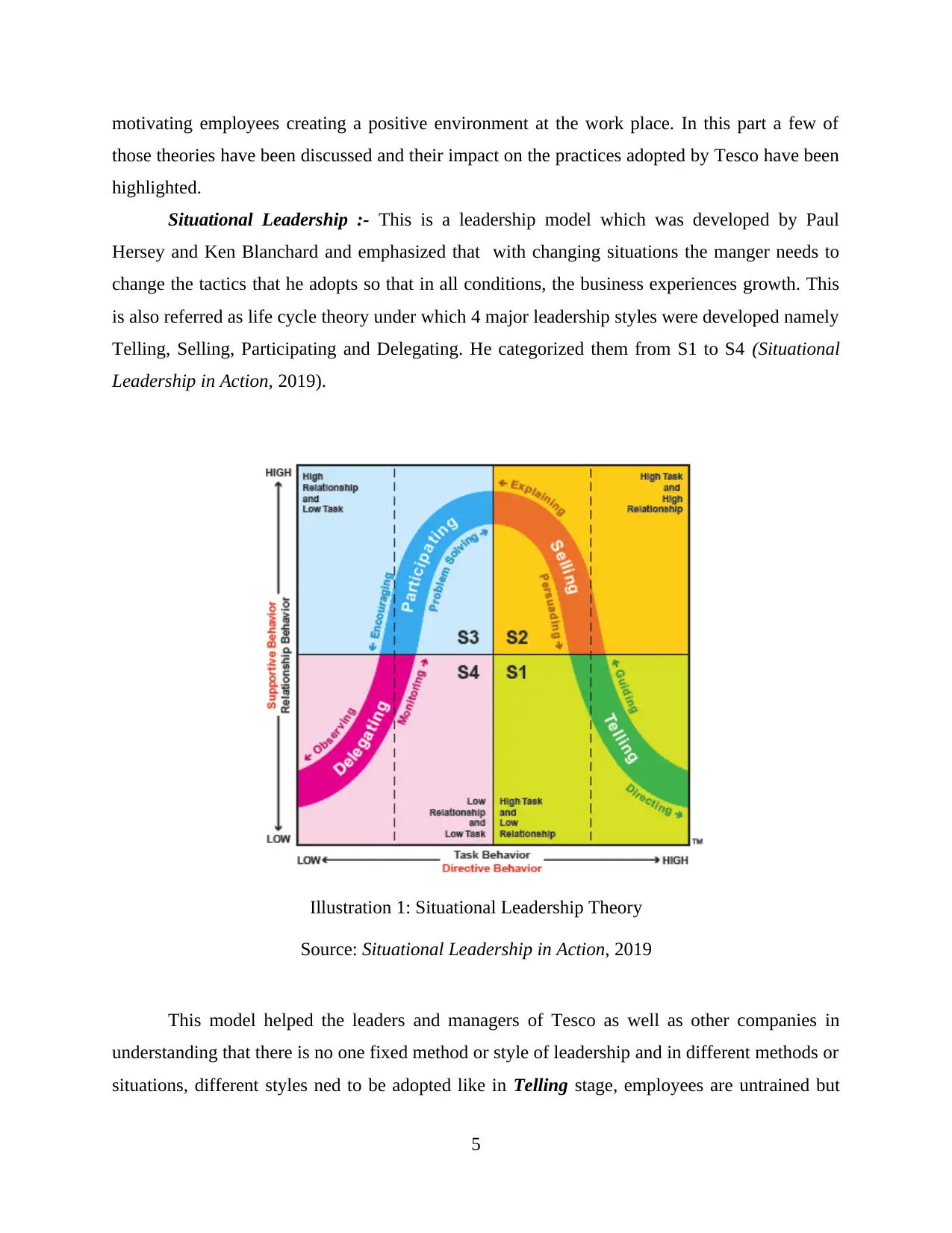
motivating employees creating a positive environment at the work place. In this part a few of
those theories have been discussed and their impact on the practices adopted by Tesco have been
highlighted.
Situational Leadership :- This is a leadership model which was developed by Paul
Hersey and Ken Blanchard and emphasized that with changing situations the manger needs to
change the tactics that he adopts so that in all conditions, the business experiences growth. This
is also referred as life cycle theory under which 4 major leadership styles were developed namely
Telling, Selling, Participating and Delegating. He categorized them from S1 to S4 (Situational
Leadership in Action, 2019).
This model helped the leaders and managers of Tesco as well as other companies in
understanding that there is no one fixed method or style of leadership and in different methods or
situations, different styles ned to be adopted like in Telling stage, employees are untrained but
5
Illustration 1: Situational Leadership Theory
Source: Situational Leadership in Action, 2019
those theories have been discussed and their impact on the practices adopted by Tesco have been
highlighted.
Situational Leadership :- This is a leadership model which was developed by Paul
Hersey and Ken Blanchard and emphasized that with changing situations the manger needs to
change the tactics that he adopts so that in all conditions, the business experiences growth. This
is also referred as life cycle theory under which 4 major leadership styles were developed namely
Telling, Selling, Participating and Delegating. He categorized them from S1 to S4 (Situational
Leadership in Action, 2019).
This model helped the leaders and managers of Tesco as well as other companies in
understanding that there is no one fixed method or style of leadership and in different methods or
situations, different styles ned to be adopted like in Telling stage, employees are untrained but
5
Illustration 1: Situational Leadership Theory
Source: Situational Leadership in Action, 2019
Paraphrase This Document
Need a fresh take? Get an instant paraphrase of this document with our AI Paraphraser
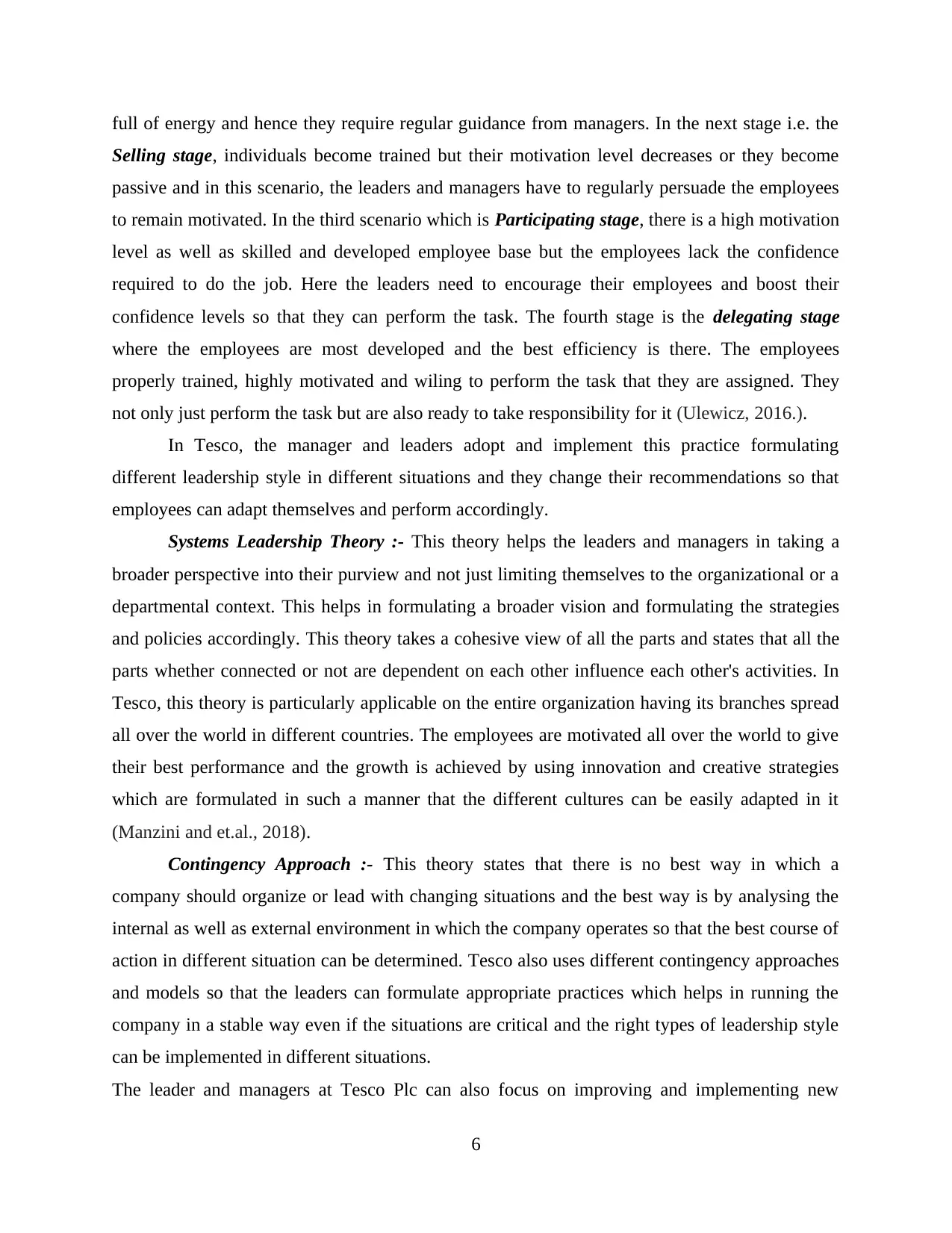
full of energy and hence they require regular guidance from managers. In the next stage i.e. the
Selling stage, individuals become trained but their motivation level decreases or they become
passive and in this scenario, the leaders and managers have to regularly persuade the employees
to remain motivated. In the third scenario which is Participating stage, there is a high motivation
level as well as skilled and developed employee base but the employees lack the confidence
required to do the job. Here the leaders need to encourage their employees and boost their
confidence levels so that they can perform the task. The fourth stage is the delegating stage
where the employees are most developed and the best efficiency is there. The employees
properly trained, highly motivated and wiling to perform the task that they are assigned. They
not only just perform the task but are also ready to take responsibility for it (Ulewicz, 2016.).
In Tesco, the manager and leaders adopt and implement this practice formulating
different leadership style in different situations and they change their recommendations so that
employees can adapt themselves and perform accordingly.
Systems Leadership Theory :- This theory helps the leaders and managers in taking a
broader perspective into their purview and not just limiting themselves to the organizational or a
departmental context. This helps in formulating a broader vision and formulating the strategies
and policies accordingly. This theory takes a cohesive view of all the parts and states that all the
parts whether connected or not are dependent on each other influence each other's activities. In
Tesco, this theory is particularly applicable on the entire organization having its branches spread
all over the world in different countries. The employees are motivated all over the world to give
their best performance and the growth is achieved by using innovation and creative strategies
which are formulated in such a manner that the different cultures can be easily adapted in it
(Manzini and et.al., 2018).
Contingency Approach :- This theory states that there is no best way in which a
company should organize or lead with changing situations and the best way is by analysing the
internal as well as external environment in which the company operates so that the best course of
action in different situation can be determined. Tesco also uses different contingency approaches
and models so that the leaders can formulate appropriate practices which helps in running the
company in a stable way even if the situations are critical and the right types of leadership style
can be implemented in different situations.
The leader and managers at Tesco Plc can also focus on improving and implementing new
6
Selling stage, individuals become trained but their motivation level decreases or they become
passive and in this scenario, the leaders and managers have to regularly persuade the employees
to remain motivated. In the third scenario which is Participating stage, there is a high motivation
level as well as skilled and developed employee base but the employees lack the confidence
required to do the job. Here the leaders need to encourage their employees and boost their
confidence levels so that they can perform the task. The fourth stage is the delegating stage
where the employees are most developed and the best efficiency is there. The employees
properly trained, highly motivated and wiling to perform the task that they are assigned. They
not only just perform the task but are also ready to take responsibility for it (Ulewicz, 2016.).
In Tesco, the manager and leaders adopt and implement this practice formulating
different leadership style in different situations and they change their recommendations so that
employees can adapt themselves and perform accordingly.
Systems Leadership Theory :- This theory helps the leaders and managers in taking a
broader perspective into their purview and not just limiting themselves to the organizational or a
departmental context. This helps in formulating a broader vision and formulating the strategies
and policies accordingly. This theory takes a cohesive view of all the parts and states that all the
parts whether connected or not are dependent on each other influence each other's activities. In
Tesco, this theory is particularly applicable on the entire organization having its branches spread
all over the world in different countries. The employees are motivated all over the world to give
their best performance and the growth is achieved by using innovation and creative strategies
which are formulated in such a manner that the different cultures can be easily adapted in it
(Manzini and et.al., 2018).
Contingency Approach :- This theory states that there is no best way in which a
company should organize or lead with changing situations and the best way is by analysing the
internal as well as external environment in which the company operates so that the best course of
action in different situation can be determined. Tesco also uses different contingency approaches
and models so that the leaders can formulate appropriate practices which helps in running the
company in a stable way even if the situations are critical and the right types of leadership style
can be implemented in different situations.
The leader and managers at Tesco Plc can also focus on improving and implementing new
6
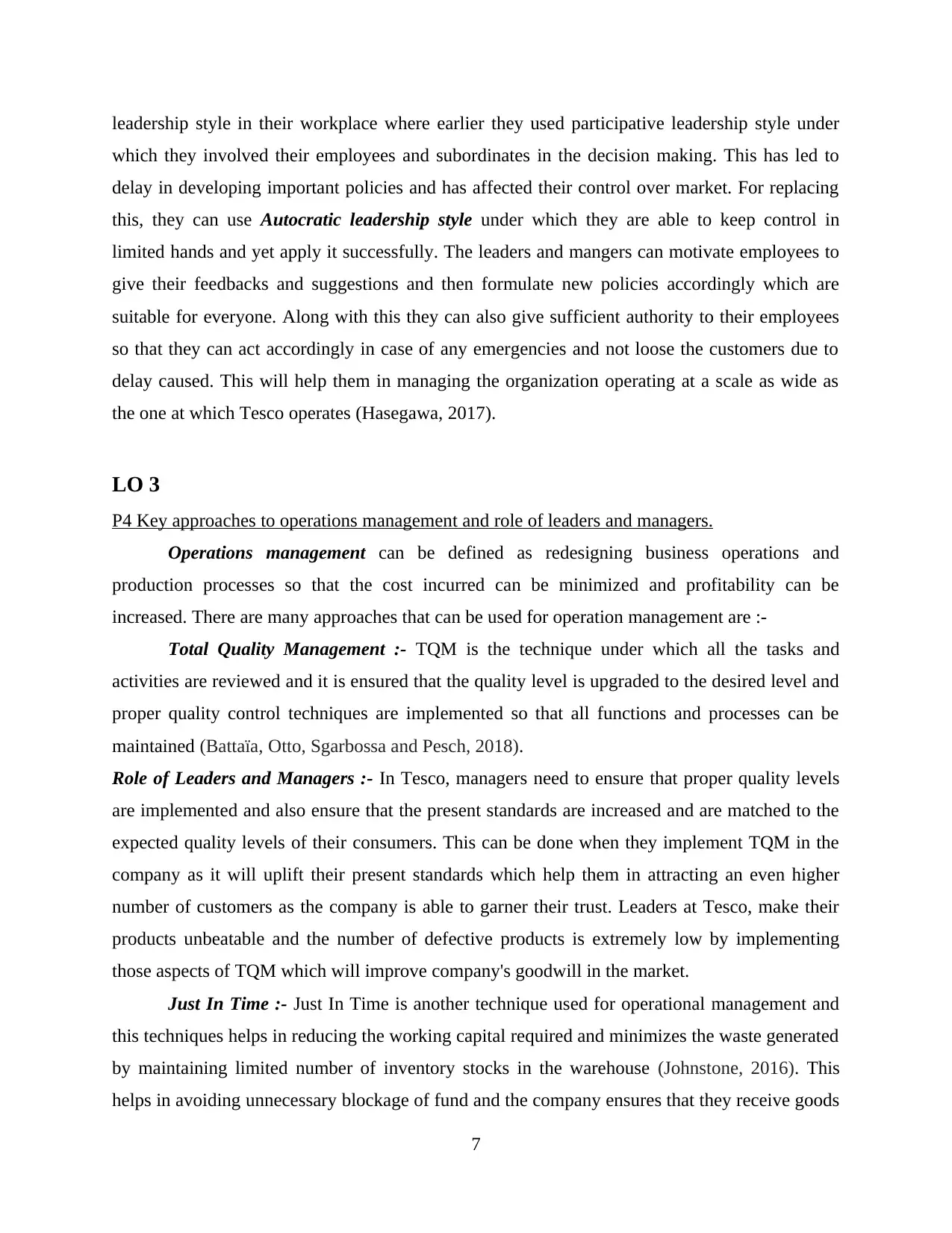
leadership style in their workplace where earlier they used participative leadership style under
which they involved their employees and subordinates in the decision making. This has led to
delay in developing important policies and has affected their control over market. For replacing
this, they can use Autocratic leadership style under which they are able to keep control in
limited hands and yet apply it successfully. The leaders and mangers can motivate employees to
give their feedbacks and suggestions and then formulate new policies accordingly which are
suitable for everyone. Along with this they can also give sufficient authority to their employees
so that they can act accordingly in case of any emergencies and not loose the customers due to
delay caused. This will help them in managing the organization operating at a scale as wide as
the one at which Tesco operates (Hasegawa, 2017).
LO 3
P4 Key approaches to operations management and role of leaders and managers.
Operations management can be defined as redesigning business operations and
production processes so that the cost incurred can be minimized and profitability can be
increased. There are many approaches that can be used for operation management are :-
Total Quality Management :- TQM is the technique under which all the tasks and
activities are reviewed and it is ensured that the quality level is upgraded to the desired level and
proper quality control techniques are implemented so that all functions and processes can be
maintained (Battaïa, Otto, Sgarbossa and Pesch, 2018).
Role of Leaders and Managers :- In Tesco, managers need to ensure that proper quality levels
are implemented and also ensure that the present standards are increased and are matched to the
expected quality levels of their consumers. This can be done when they implement TQM in the
company as it will uplift their present standards which help them in attracting an even higher
number of customers as the company is able to garner their trust. Leaders at Tesco, make their
products unbeatable and the number of defective products is extremely low by implementing
those aspects of TQM which will improve company's goodwill in the market.
Just In Time :- Just In Time is another technique used for operational management and
this techniques helps in reducing the working capital required and minimizes the waste generated
by maintaining limited number of inventory stocks in the warehouse (Johnstone, 2016). This
helps in avoiding unnecessary blockage of fund and the company ensures that they receive goods
7
which they involved their employees and subordinates in the decision making. This has led to
delay in developing important policies and has affected their control over market. For replacing
this, they can use Autocratic leadership style under which they are able to keep control in
limited hands and yet apply it successfully. The leaders and mangers can motivate employees to
give their feedbacks and suggestions and then formulate new policies accordingly which are
suitable for everyone. Along with this they can also give sufficient authority to their employees
so that they can act accordingly in case of any emergencies and not loose the customers due to
delay caused. This will help them in managing the organization operating at a scale as wide as
the one at which Tesco operates (Hasegawa, 2017).
LO 3
P4 Key approaches to operations management and role of leaders and managers.
Operations management can be defined as redesigning business operations and
production processes so that the cost incurred can be minimized and profitability can be
increased. There are many approaches that can be used for operation management are :-
Total Quality Management :- TQM is the technique under which all the tasks and
activities are reviewed and it is ensured that the quality level is upgraded to the desired level and
proper quality control techniques are implemented so that all functions and processes can be
maintained (Battaïa, Otto, Sgarbossa and Pesch, 2018).
Role of Leaders and Managers :- In Tesco, managers need to ensure that proper quality levels
are implemented and also ensure that the present standards are increased and are matched to the
expected quality levels of their consumers. This can be done when they implement TQM in the
company as it will uplift their present standards which help them in attracting an even higher
number of customers as the company is able to garner their trust. Leaders at Tesco, make their
products unbeatable and the number of defective products is extremely low by implementing
those aspects of TQM which will improve company's goodwill in the market.
Just In Time :- Just In Time is another technique used for operational management and
this techniques helps in reducing the working capital required and minimizes the waste generated
by maintaining limited number of inventory stocks in the warehouse (Johnstone, 2016). This
helps in avoiding unnecessary blockage of fund and the company ensures that they receive goods
7
⊘ This is a preview!⊘
Do you want full access?
Subscribe today to unlock all pages.

Trusted by 1+ million students worldwide
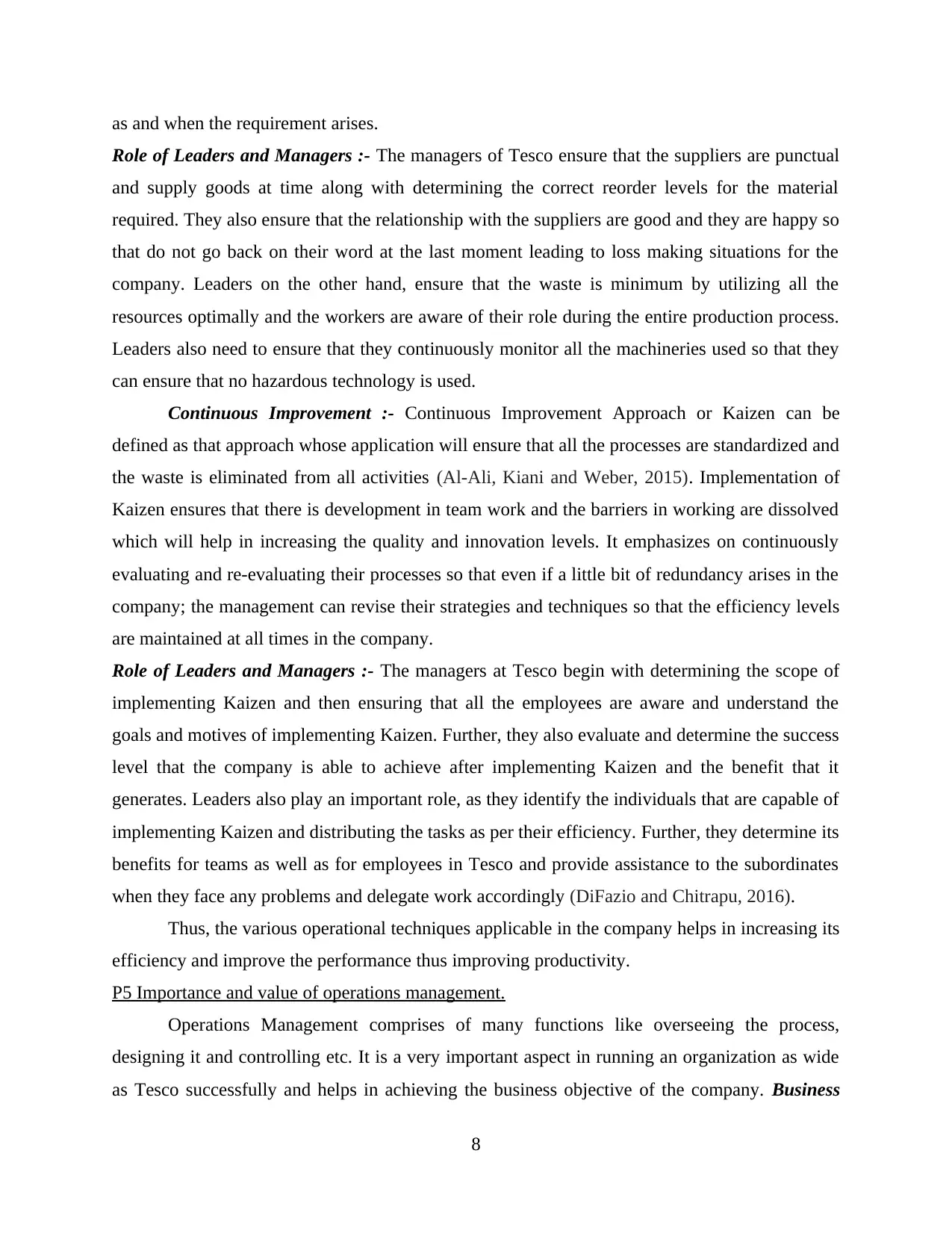
as and when the requirement arises.
Role of Leaders and Managers :- The managers of Tesco ensure that the suppliers are punctual
and supply goods at time along with determining the correct reorder levels for the material
required. They also ensure that the relationship with the suppliers are good and they are happy so
that do not go back on their word at the last moment leading to loss making situations for the
company. Leaders on the other hand, ensure that the waste is minimum by utilizing all the
resources optimally and the workers are aware of their role during the entire production process.
Leaders also need to ensure that they continuously monitor all the machineries used so that they
can ensure that no hazardous technology is used.
Continuous Improvement :- Continuous Improvement Approach or Kaizen can be
defined as that approach whose application will ensure that all the processes are standardized and
the waste is eliminated from all activities (Al-Ali, Kiani and Weber, 2015). Implementation of
Kaizen ensures that there is development in team work and the barriers in working are dissolved
which will help in increasing the quality and innovation levels. It emphasizes on continuously
evaluating and re-evaluating their processes so that even if a little bit of redundancy arises in the
company; the management can revise their strategies and techniques so that the efficiency levels
are maintained at all times in the company.
Role of Leaders and Managers :- The managers at Tesco begin with determining the scope of
implementing Kaizen and then ensuring that all the employees are aware and understand the
goals and motives of implementing Kaizen. Further, they also evaluate and determine the success
level that the company is able to achieve after implementing Kaizen and the benefit that it
generates. Leaders also play an important role, as they identify the individuals that are capable of
implementing Kaizen and distributing the tasks as per their efficiency. Further, they determine its
benefits for teams as well as for employees in Tesco and provide assistance to the subordinates
when they face any problems and delegate work accordingly (DiFazio and Chitrapu, 2016).
Thus, the various operational techniques applicable in the company helps in increasing its
efficiency and improve the performance thus improving productivity.
P5 Importance and value of operations management.
Operations Management comprises of many functions like overseeing the process,
designing it and controlling etc. It is a very important aspect in running an organization as wide
as Tesco successfully and helps in achieving the business objective of the company. Business
8
Role of Leaders and Managers :- The managers of Tesco ensure that the suppliers are punctual
and supply goods at time along with determining the correct reorder levels for the material
required. They also ensure that the relationship with the suppliers are good and they are happy so
that do not go back on their word at the last moment leading to loss making situations for the
company. Leaders on the other hand, ensure that the waste is minimum by utilizing all the
resources optimally and the workers are aware of their role during the entire production process.
Leaders also need to ensure that they continuously monitor all the machineries used so that they
can ensure that no hazardous technology is used.
Continuous Improvement :- Continuous Improvement Approach or Kaizen can be
defined as that approach whose application will ensure that all the processes are standardized and
the waste is eliminated from all activities (Al-Ali, Kiani and Weber, 2015). Implementation of
Kaizen ensures that there is development in team work and the barriers in working are dissolved
which will help in increasing the quality and innovation levels. It emphasizes on continuously
evaluating and re-evaluating their processes so that even if a little bit of redundancy arises in the
company; the management can revise their strategies and techniques so that the efficiency levels
are maintained at all times in the company.
Role of Leaders and Managers :- The managers at Tesco begin with determining the scope of
implementing Kaizen and then ensuring that all the employees are aware and understand the
goals and motives of implementing Kaizen. Further, they also evaluate and determine the success
level that the company is able to achieve after implementing Kaizen and the benefit that it
generates. Leaders also play an important role, as they identify the individuals that are capable of
implementing Kaizen and distributing the tasks as per their efficiency. Further, they determine its
benefits for teams as well as for employees in Tesco and provide assistance to the subordinates
when they face any problems and delegate work accordingly (DiFazio and Chitrapu, 2016).
Thus, the various operational techniques applicable in the company helps in increasing its
efficiency and improve the performance thus improving productivity.
P5 Importance and value of operations management.
Operations Management comprises of many functions like overseeing the process,
designing it and controlling etc. It is a very important aspect in running an organization as wide
as Tesco successfully and helps in achieving the business objective of the company. Business
8
Paraphrase This Document
Need a fresh take? Get an instant paraphrase of this document with our AI Paraphraser
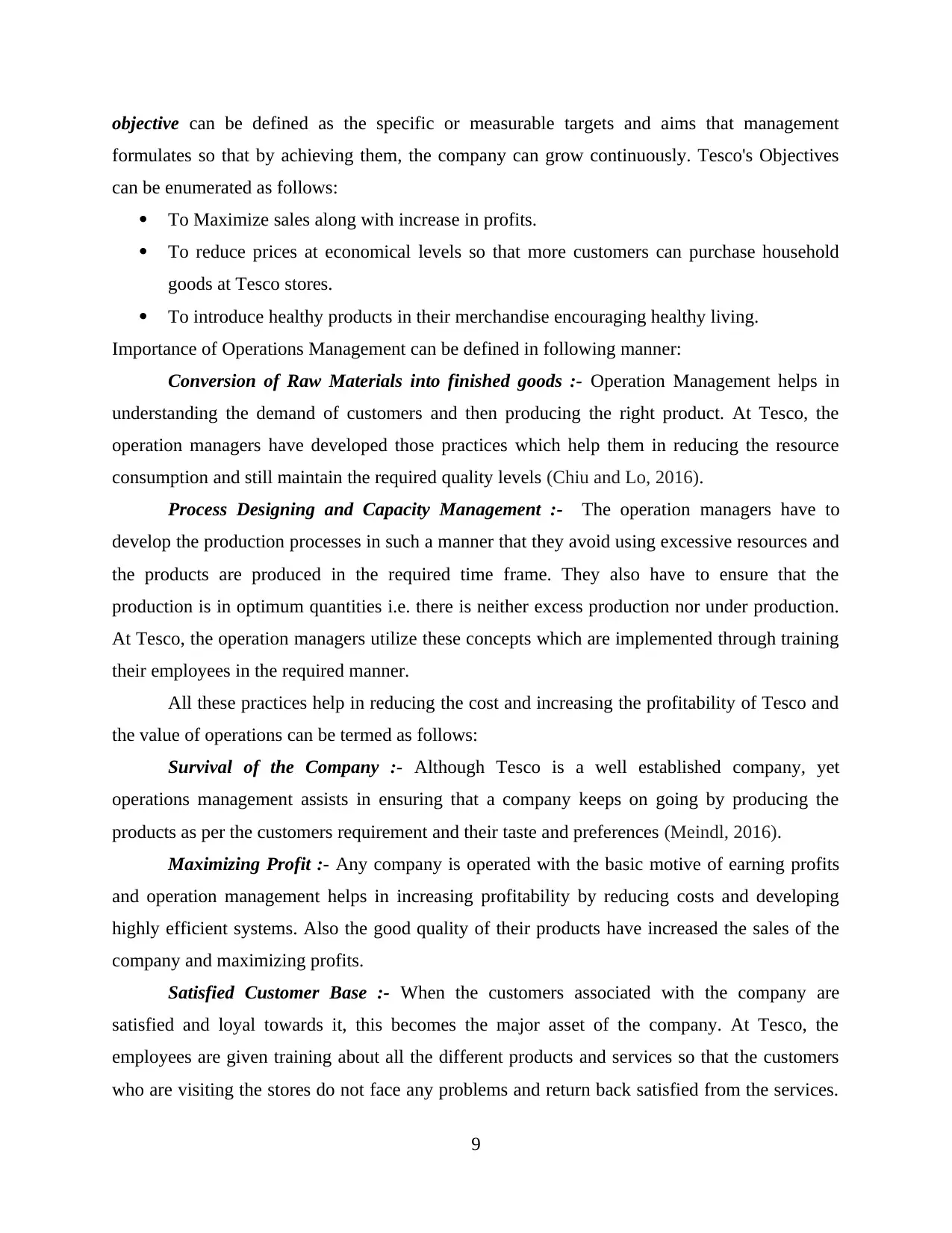
objective can be defined as the specific or measurable targets and aims that management
formulates so that by achieving them, the company can grow continuously. Tesco's Objectives
can be enumerated as follows:
To Maximize sales along with increase in profits.
To reduce prices at economical levels so that more customers can purchase household
goods at Tesco stores.
To introduce healthy products in their merchandise encouraging healthy living.
Importance of Operations Management can be defined in following manner:
Conversion of Raw Materials into finished goods :- Operation Management helps in
understanding the demand of customers and then producing the right product. At Tesco, the
operation managers have developed those practices which help them in reducing the resource
consumption and still maintain the required quality levels (Chiu and Lo, 2016).
Process Designing and Capacity Management :- The operation managers have to
develop the production processes in such a manner that they avoid using excessive resources and
the products are produced in the required time frame. They also have to ensure that the
production is in optimum quantities i.e. there is neither excess production nor under production.
At Tesco, the operation managers utilize these concepts which are implemented through training
their employees in the required manner.
All these practices help in reducing the cost and increasing the profitability of Tesco and
the value of operations can be termed as follows:
Survival of the Company :- Although Tesco is a well established company, yet
operations management assists in ensuring that a company keeps on going by producing the
products as per the customers requirement and their taste and preferences (Meindl, 2016).
Maximizing Profit :- Any company is operated with the basic motive of earning profits
and operation management helps in increasing profitability by reducing costs and developing
highly efficient systems. Also the good quality of their products have increased the sales of the
company and maximizing profits.
Satisfied Customer Base :- When the customers associated with the company are
satisfied and loyal towards it, this becomes the major asset of the company. At Tesco, the
employees are given training about all the different products and services so that the customers
who are visiting the stores do not face any problems and return back satisfied from the services.
9
formulates so that by achieving them, the company can grow continuously. Tesco's Objectives
can be enumerated as follows:
To Maximize sales along with increase in profits.
To reduce prices at economical levels so that more customers can purchase household
goods at Tesco stores.
To introduce healthy products in their merchandise encouraging healthy living.
Importance of Operations Management can be defined in following manner:
Conversion of Raw Materials into finished goods :- Operation Management helps in
understanding the demand of customers and then producing the right product. At Tesco, the
operation managers have developed those practices which help them in reducing the resource
consumption and still maintain the required quality levels (Chiu and Lo, 2016).
Process Designing and Capacity Management :- The operation managers have to
develop the production processes in such a manner that they avoid using excessive resources and
the products are produced in the required time frame. They also have to ensure that the
production is in optimum quantities i.e. there is neither excess production nor under production.
At Tesco, the operation managers utilize these concepts which are implemented through training
their employees in the required manner.
All these practices help in reducing the cost and increasing the profitability of Tesco and
the value of operations can be termed as follows:
Survival of the Company :- Although Tesco is a well established company, yet
operations management assists in ensuring that a company keeps on going by producing the
products as per the customers requirement and their taste and preferences (Meindl, 2016).
Maximizing Profit :- Any company is operated with the basic motive of earning profits
and operation management helps in increasing profitability by reducing costs and developing
highly efficient systems. Also the good quality of their products have increased the sales of the
company and maximizing profits.
Satisfied Customer Base :- When the customers associated with the company are
satisfied and loyal towards it, this becomes the major asset of the company. At Tesco, the
employees are given training about all the different products and services so that the customers
who are visiting the stores do not face any problems and return back satisfied from the services.
9
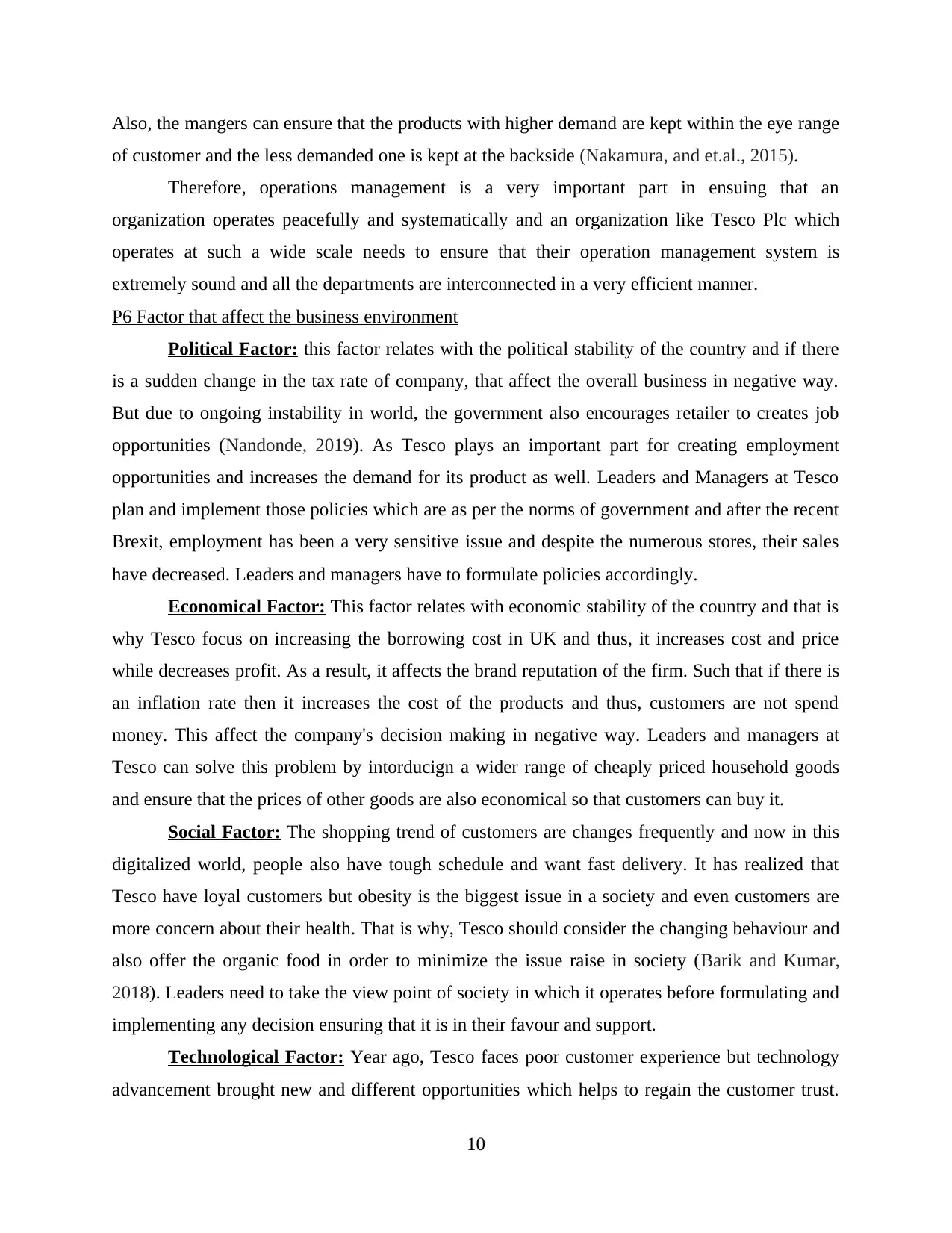
Also, the mangers can ensure that the products with higher demand are kept within the eye range
of customer and the less demanded one is kept at the backside (Nakamura, and et.al., 2015).
Therefore, operations management is a very important part in ensuing that an
organization operates peacefully and systematically and an organization like Tesco Plc which
operates at such a wide scale needs to ensure that their operation management system is
extremely sound and all the departments are interconnected in a very efficient manner.
P6 Factor that affect the business environment
Political Factor: this factor relates with the political stability of the country and if there
is a sudden change in the tax rate of company, that affect the overall business in negative way.
But due to ongoing instability in world, the government also encourages retailer to creates job
opportunities (Nandonde, 2019). As Tesco plays an important part for creating employment
opportunities and increases the demand for its product as well. Leaders and Managers at Tesco
plan and implement those policies which are as per the norms of government and after the recent
Brexit, employment has been a very sensitive issue and despite the numerous stores, their sales
have decreased. Leaders and managers have to formulate policies accordingly.
Economical Factor: This factor relates with economic stability of the country and that is
why Tesco focus on increasing the borrowing cost in UK and thus, it increases cost and price
while decreases profit. As a result, it affects the brand reputation of the firm. Such that if there is
an inflation rate then it increases the cost of the products and thus, customers are not spend
money. This affect the company's decision making in negative way. Leaders and managers at
Tesco can solve this problem by intorducign a wider range of cheaply priced household goods
and ensure that the prices of other goods are also economical so that customers can buy it.
Social Factor: The shopping trend of customers are changes frequently and now in this
digitalized world, people also have tough schedule and want fast delivery. It has realized that
Tesco have loyal customers but obesity is the biggest issue in a society and even customers are
more concern about their health. That is why, Tesco should consider the changing behaviour and
also offer the organic food in order to minimize the issue raise in society (Barik and Kumar,
2018). Leaders need to take the view point of society in which it operates before formulating and
implementing any decision ensuring that it is in their favour and support.
Technological Factor: Year ago, Tesco faces poor customer experience but technology
advancement brought new and different opportunities which helps to regain the customer trust.
10
of customer and the less demanded one is kept at the backside (Nakamura, and et.al., 2015).
Therefore, operations management is a very important part in ensuing that an
organization operates peacefully and systematically and an organization like Tesco Plc which
operates at such a wide scale needs to ensure that their operation management system is
extremely sound and all the departments are interconnected in a very efficient manner.
P6 Factor that affect the business environment
Political Factor: this factor relates with the political stability of the country and if there
is a sudden change in the tax rate of company, that affect the overall business in negative way.
But due to ongoing instability in world, the government also encourages retailer to creates job
opportunities (Nandonde, 2019). As Tesco plays an important part for creating employment
opportunities and increases the demand for its product as well. Leaders and Managers at Tesco
plan and implement those policies which are as per the norms of government and after the recent
Brexit, employment has been a very sensitive issue and despite the numerous stores, their sales
have decreased. Leaders and managers have to formulate policies accordingly.
Economical Factor: This factor relates with economic stability of the country and that is
why Tesco focus on increasing the borrowing cost in UK and thus, it increases cost and price
while decreases profit. As a result, it affects the brand reputation of the firm. Such that if there is
an inflation rate then it increases the cost of the products and thus, customers are not spend
money. This affect the company's decision making in negative way. Leaders and managers at
Tesco can solve this problem by intorducign a wider range of cheaply priced household goods
and ensure that the prices of other goods are also economical so that customers can buy it.
Social Factor: The shopping trend of customers are changes frequently and now in this
digitalized world, people also have tough schedule and want fast delivery. It has realized that
Tesco have loyal customers but obesity is the biggest issue in a society and even customers are
more concern about their health. That is why, Tesco should consider the changing behaviour and
also offer the organic food in order to minimize the issue raise in society (Barik and Kumar,
2018). Leaders need to take the view point of society in which it operates before formulating and
implementing any decision ensuring that it is in their favour and support.
Technological Factor: Year ago, Tesco faces poor customer experience but technology
advancement brought new and different opportunities which helps to regain the customer trust.
10
⊘ This is a preview!⊘
Do you want full access?
Subscribe today to unlock all pages.

Trusted by 1+ million students worldwide
1 out of 16
Related Documents
Your All-in-One AI-Powered Toolkit for Academic Success.
+13062052269
info@desklib.com
Available 24*7 on WhatsApp / Email
![[object Object]](/_next/static/media/star-bottom.7253800d.svg)
Unlock your academic potential
Copyright © 2020–2025 A2Z Services. All Rights Reserved. Developed and managed by ZUCOL.





